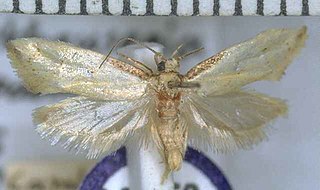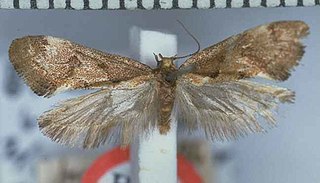Related Research Articles
Flexiptera is a monotypic moth genus in the family Gelechiidae erected by Anthonie Johannes Theodorus Janse in 1958. Its only species, Flexiptera revoluta, was first described by Edward Meyrick in 1918. It is found in South Africa.
Gelechia epiphloea is a moth of the family Gelechiidae first described by Edward Meyrick in 1913. It is found in South Africa.
Gelechia sematica is a moth of the family Gelechiidae first described by Edward Meyrick in 1913. It is found in Namibia and South Africa.
Parathectis farinata is a moth of the family Gelechiidae. It was described by Edward Meyrick in 1913. It is found in South Africa.
Ephysteris infirma is a moth in the family Gelechiidae. It was described by Edward Meyrick in 1912. It is found in the Democratic Republic of the Congo and South Africa (KwaZulu-Natal).
Ephysteris semiophanes is a moth in the family Gelechiidae. It was described by Edward Meyrick in 1918. It is found in Sri Lanka.
Ephysteris sirota is a moth in the family Gelechiidae. It was described by Edward Meyrick in 1908. It is found in the South Africa provinces of Gauteng, KwaZulu-Natal and Limpopo.
Ephysteris suasoria is a moth in the family Gelechiidae. It was described by Edward Meyrick in 1918. It is found in southern India and Palestine.
Ephysteris brachypogon is a moth in the family Gelechiidae. It was described by Edward Meyrick in 1937. It is found in South Africa.
Lasiarchis pycnodes is a moth in the family Gelechiidae. It was described by Edward Meyrick in 1909. It is found in Gauteng, South Africa.
Parapsectris ferulata is a moth in the family Gelechiidae. It was described by Edward Meyrick in 1918. It is found in South Africa (KwaZulu-Natal).
Aristotelia cytheraea is a moth of the family Gelechiidae. It was described by Edward Meyrick in 1917. It is found in Colombia.
Aristotelia ptilastis is a moth of the family Gelechiidae. It was described by Edward Meyrick in 1909. It is found in South Africa, where it has been recorded from the Western Cape.
Aristotelia schematias is a moth of the family Gelechiidae. It was described by Edward Meyrick in 1911. It is found on Mahé and Silhouette in the Seychelles.
Pyncostola magnanima is a moth of the family Gelechiidae. It was described by Edward Meyrick in 1912. It is found in South Africa, where it was recorded from what was then the Orange Free State.
Photodotis prochalina is a moth of the family Gelechiidae. It was described by Edward Meyrick in 1911. It is found in South Africa.
Dicranucha serialis is a moth of the family Gelechiidae. It was described by Edward Meyrick in 1908. It is found in the Democratic Republic of the Congo, Mozambique and Gauteng, South Africa.
Hypercallia alexandra is a moth in the family Depressariidae. It was described by Edward Meyrick in 1909. It is found in Peru.

Tingena apanthes is a species of moth in the family Oecophoridae. It is endemic to New Zealand and found in the North Island. The adults are on the wing from October to December. It appears associated with Leptospermum species and it has been hypothesised that the appearance of the adults of this species imitates faded Leptospermum leaves.

Tingena brachyacma is a species of moth in the family Oecophoridae. It is endemic to New Zealand and has been found in the south of the South Island. This species inhabits open swamps, native forest and scrubland and has been collected amongst Leptospermum. The adults of the species are on the wing in November and December.
References
- ↑ Savela, Markku, ed. (February 10, 2015). "Ephysteris synecta (Meyrick, 1909)". Lepidoptera and Some Other Life Forms. Retrieved August 28, 2020.
- ↑ De Prins, J. & De Prins, W. (2019). "Microcraspedus synecta (Meyrick, 1909)". Afromoths. Retrieved August 28, 2020.
 This article incorporates text from this source, which is in the public domain .
This article incorporates text from this source, which is in the public domain . - ↑ Meyrick, E. (November 1909). "Descriptions of Tansvaal Micro-Lepidoptera". Annals of the Transvaal Museum. 2 (1): 12–13 – via Sabinet.